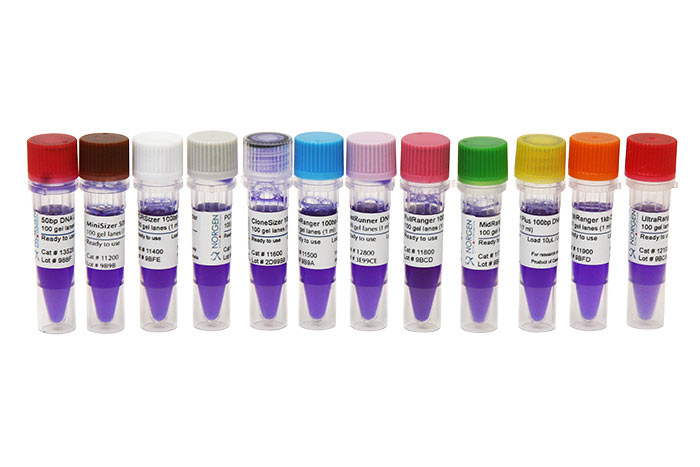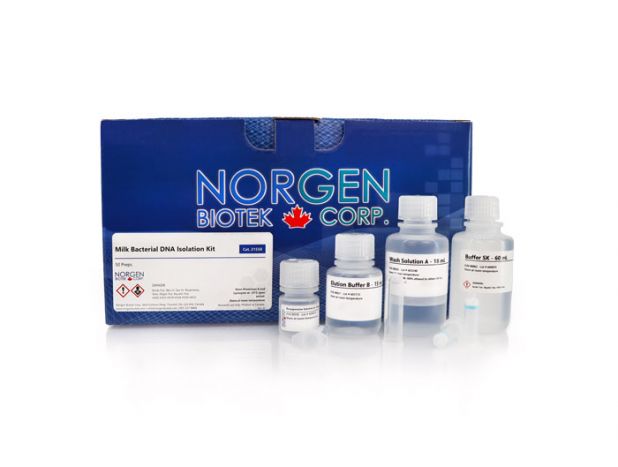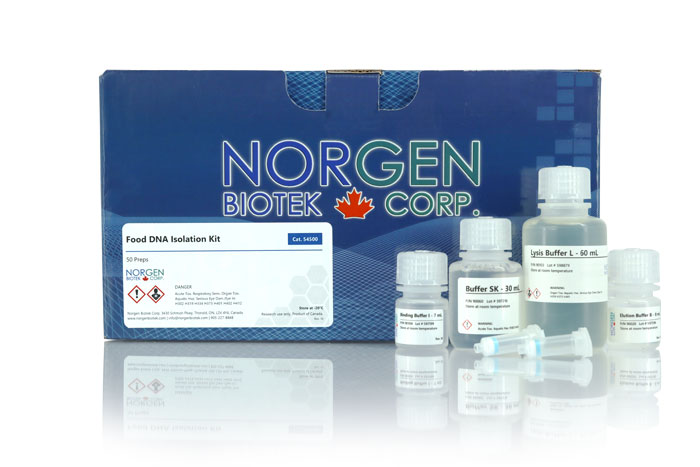Bacterial Genomic DNA Isolation Kit

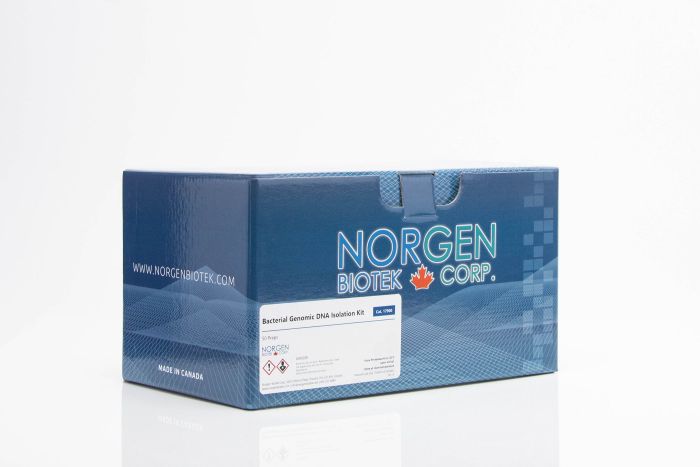
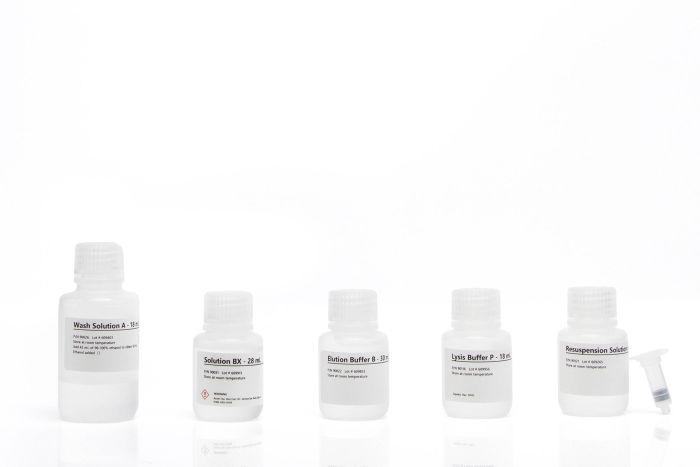
For research use only and NOT intended for in vitro diagnostics.
Bacterial Genomic DNA Isolation Kit
Register today to receive an exclusive 15% off* on your first order.
Supporting Data
Figure 1. Isolation of Genomic DNA from both Gram Positive and Gram Negative Bacteria. The Bacterial Genomic DNA Isolation Kit was used to isolate genomic DNA from 1 mL overnight culture (1 x 109 cells) of the Gram negative bacteria E. coli (Lanes 1 and 2), the lysozyme-resistant Gram positive bacteria B. cereus (Lanes 3 and 4) and the Gram positive bacteria M. luteus (Lanes 5 and 6). Lane M is Norgen's UltraRanger 1kb DNA Ladder. For analysis 5 µL of the 200 µL eluted genomic DNA were loaded on a 1X TAE, 0.9% agarose gel.
Figure 2. High Yield Purification. The high yield of Norgen's Bacterial Genomic DNA Isolation Kit is illustrated by purifying genomic DNA from 1 mL overnight culture (1 x 109 cells) of both a Gram positive (B. cereus) and a Gram negative strain (E coli), and comparing the yield with two major competitors. The quantification of the DNA yield was performed by resolving 5 µL of the 200 µL of eluted DNA on a 1X TAE, 0.9% agarose gel followed by densitometry. With both types of bacteria, Norgen's kit was found to give a higher recovery than the competitor’s kits.
|
Kit Specifications (Spin Columns)
|
|
|
Input
|
2 x 109 bacterial cells
|
|
Column Binding Capacity
|
25 µg
|
|
Average Yield*
|
Up to 20 µg
|
| Time to Complete 10 Purifications |
1 hour
|
* Yield will vary depending on the type of sample processed
Storage Conditions and Product Stability
All solutions should be kept tightly sealed and stored at room temperature. This kit is stable for 2 years after the date of shipment. The kit contains a ready-to-use Proteinase K, which is dissolved in a specially prepared storage buffer. The buffered Proteinase K is stable for up to 2 years after the date of shipment when stored at room temperature.
| Component | Cat. 17900 (50 preps) | Cat. 17950 (192 preps) |
|---|---|---|
| Resuspension Solution A | 20 mL | 60 mL |
| Lysis Buffer P | 18 mL | 60 mL |
| Solution BX | 28 mL | 110 mL |
| Wash Solution A | 18 mL | 2 x 38 mL |
| Elution Buffer B | 30 mL | 2 x 30 mL |
| Proteinase K | 12 mg | 50 mg |
| Spin Columns | 50 | - |
| 96-Well Plate | - | 2 |
| Adhesive Tape | - | 4 |
| Collection Plate | - | 2 |
| Collection Tubes | 50 | - |
| Elution Tubes (1.7 mL) | 50 | - |
| Elution Plate | - | 2 |
| Product Insert | 1 | 1 |
Documentation
FAQs
Spin Column, High Throughput
Column clogging can result from the following:
- The sample is too large.
Too many cells were applied to the column. Ensure that the amount of cells used is less than 2 x 109 viable cells, and that no more than 1 mL of culture is applied to the column/well. Clogging can be alleviated by increasing the g force and/or centrifuging for a longer period of time until the lysate passes through the column.
- Insufficient Vacuum (for High-throughput only).
Ensure that a vacuum pressure of at least -650 mbar or -25 in. Hg is developed.
- Centrifuge temperature is too low.
Ensure that the centrifuge remains at room temperature throughout the procedure. Temperatures below 15℃ may cause precipitates to form that can cause the wells to clog.
Experiencing gelatinous lysate prior to loading onto the column may be due to:
- The lysate/binding solution mixture is not homogeneous.
To ensure a homogeneous solution, vortex for 10-15 seconds before applying the lysate to the spin column.
- The sample is too large.
Too many cells are in the lysate preparation. Ensure that the amount of cells used is less than 2 x 109 viable cells, and that no more than 1 mL of culture is applied to the column/well.
A low genomic DNA yield may be caused by the following:
- The sample is old/overgrown.
The culture may have been overgrown, allowing lysis of older cells to occur more readily. This will lead to premature degradation of the genomic DNA. It may be necessary to use bacterial cultures before they reach maximum density.
- Incomplete lysis of cells.
Extend the incubation time of Proteinase K digestion or reduce the amount of bacterial cells used for lysis. Increase the lysozyme incubation time for gram-positive strains.
- The DNA elution is incomplete.
Ensure that centrifugation at 20,000 x g is performed after the 3,000 x g centrifugation cycle to ensure that all the DNA is eluted.
Sheared genomic DNA could be caused by:
- Improper handling of genomic DNA.
Pipetting steps should be handled as gently as possible. Reduce vortexing times during mixing steps (no more than 10-15 seconds).
- The cells are old.
Older cultures contain prematurely lysed cells which release endonucleases and can degrade DNA. Fresh cultures are recommended.
If the DNA does not perform well in downstream applications, it may be due to one or more of the following:
- DNA was not washed two times with the provided Wash Solution A.
Ensure the column/plate was washed two times with Wash Solution A. An additional wash with Wash Solution A can improve DNA performance in downstream applications, although it may reduce DNA yield.
- Ethanol carryover.
Ensure that the column/plate drying step after the Wash procedure is performed in order to remove traces of ethanol prior to elution. Ethanol is known to interfere with many downstream applications.
Yes, the DNA from this kit is good for both Nanopore sequencing and Long-read sequencing. Please contact our Tech support team at support@norgenbiotek.com and ask for reference publications.




